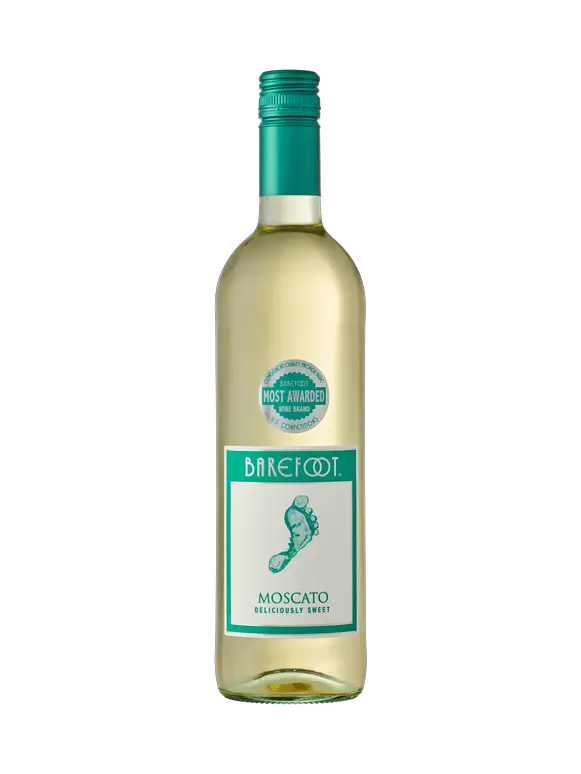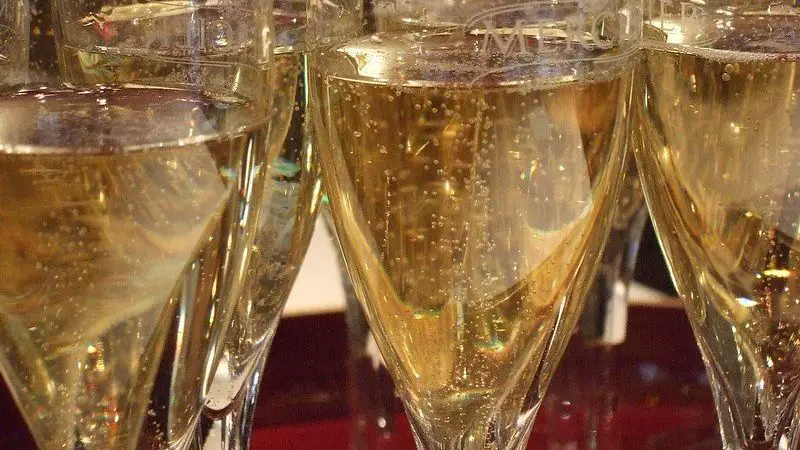| Characteristics | Moscato | Champagne |
|---|---|---|
| Hue | Pale lemon | Pale to Medium lemon |
| Color | White | White |
| Aromas | Musky, orange blossom, tropical fruit | Citrus, stone, and brioche |
| Sweetness | Mostly sweet | Almost always dry |
| Acid | Medium to high | High |
| Alcohol (%) | 5-11% | 11% – 13% |
| Body | Light | Light to Medium (-) |
| Intensity | Medium | Medium (less than Moscato) |
| Bubbles | Can be still, Often slightly effervescent, can be fully sparkling | Fully Sparkling |
| Grape | Moscato Bianco | Chardonnay, Pinot Meunier, Pinot Noir |
| Key Growing Regions | Italy, California, Australia | Champagne, France |
| Classic Pairings | Salads, fruits, light cheeses | Creamy sauces, seafood, festivities |
| Price Range | $5-$20 | $30-$80+ |
If you’re comparing Moscato vs Champagne, you’re probably thinking of the semi-sparkling or fully sparkling version of Moscato, often called Moscato d’Asti, Asti, or Spumante. So Moscato vs Champagne is a natural comparison.
Moscato is always sweet, more aromatic, and often less bubbly than Champagne, with tropical fruits and floral notes. Champagne is usually dry and always fully sparkling with citrus, tree, and bready aromas. Moscato is less expensive than Champagne.
Here’s what you need to know about Moscato vs Champagne.
- What Is Moscato Wine?
- Champagne Basics: World-Famous Sparkling Wine
- Wine Comparison: Moscato vs Champagne
- Moscato vs Champagne Winemaking
- Moscato vs. Champagne: Food Pairings and Serving Temperature
- Which Is More Expensive, Moscato vs Champagne?
- Which Is Better, Moscato vs Champagne?
- Final Thoughts – Moscato vs Champagne?
- Thirsty for More?
What Is Moscato Wine?

If you’re comparing Moscato and Champagne, then you’re probably thinking about the light, sweetish white wine that has a slight effervescence to it. The most famous of this style of wine is Moscato d’Asti DOC, from Italy’s northwestern Piemonte region.
If you’re comparing a fully sparkling Moscato wine to Champagne, you’re drinking a spumante style.
Jargon Alert: DOC stands for Denominazione di Origine Controllata (literally Controlled Designation of Origin), which is a demarcated region where a wine style comes from in Italy. Here are all of the Italian wine classifications explained (just in case you’re curious).
Moscato d’Asti, or just Asti, is made from a cultivar of Moscato grapes (there’s no actual grape called “Muscat”, which is unhelpful. The grape that makes your lovely fizzy Moscato is Moscato Bianco, or Muscat Blanc a Petit Grains, one of the most perfumed and aromatic of the Muscat family.
Helpful Tip: Here’s a rundown of everything you need to know about Muscat and its many versions.
Champagne Basics: World-Famous Sparkling Wine

Champagne is the most famous sparkling wine in the world. The most common style is a blend of grapes: Chardonnay, Pinot Noir, and Pinot Meunier. Champagne is always fully sparkling and sold with a wire cage closing and a heavier bottle that can withstand the wine under pressure. Champagne is almost always made in a non-vintage, dry style. Champagne is a high-acid wine with crisp citrus notes and a subtle bread and toast note that comes from how the wine is made.
Fun Wine Fact: To be called Champagne, the wine must be made in the Champagne region of France in one of 5 sub-regions: Montagne de Reims, Vallee de la Marne, Cote de Blancs, Cote de Sezanne, or Cote des Bars.
Wine Comparison: Moscato vs Champagne
Here’s a quick side-by-side that covers the most common styles of Moscato vs Champagne.
Moscato Wine Profile
- Sweetness: Moscato is typically produced in a sweet style, offering noticeable residual sugar.
- Alcohol: Moscato wines generally have a low alcohol content, ranging from around 5%-8% ABV.
- Body: Known for its light body, Moscato provides a refreshing and easy-drinking experience.
- Acid: Moscatos will typically have less biting acid than Champagne.
- Flavor and Aroma Intensity: Moscato exhibits delicate tropical fruit flavors and floral aromas.
- Flavors: The flavor profile often includes notes of peach, apricot, orange blossom, and sometimes a touch of honey.
Champagne Wine Profile
- Sweetness: The most common style of Champagne is Brut, which can have 0-12 grams per liter of sugar (yes, that’s unhelpful), but the wine’s high acid will make tasting the sugar difficult,
- Alcohol: By regulation, Champagne must have between 11%-13% ABV.
- Body: Champagne is known for its medium body
- Acid: Champagne has racy acidity, much more pronounced than Moscato
- Flavor and Aroma Intensity: Champagne will have citrus and green apple bread and toast notes
- Flavors: The flavor profile can include a mineral notes, white flower, lemon curd, citrus peel, grapefruit, yeasty notes, and toast.
Check out these fun Champagne facts.
Are Moscato and Champagne Similar?
Like Champagne, Moscato can be made into a fully sparkling style (spumante). Like Moscato, Champagne can be made into a sweet style (look for “doux” on the label). Both wines have a rich heritage linked to the regions where they were born.
Helpful Wine Buying Tip: Here’s a quick guide on how to figure out if the bottle of wine you’re holding is sweet or dry.
What Is the Difference Between Moscato and Champagne?
What you’re probably thinking of as Moscato is always crafted in a sweet, slightly bubbly style that has a lovely musk, or perfumed aroma. Champagne is always made in a fully sparkling, dry style with much higher acid. Moscato will have more intense perfume than Champagne. Champagne costs more than Moscato thanks to more challenging grape growing conditions and a more involved winemaking process.
Helpful Wine Buying Tip: Here’s a comprehensive guide on how a bottle of wine gets priced.
Moscato vs Champagne Winemaking

Winemakers craft Moscato to capture the CO2 produced during fermentation. The winemakers stop fermentation early. This process results in the slightly effervescent quality along with the sweet nature of Moscato wines.
Champagne starts its journey as a fully dry base wine. The winemakers then add a liquid mixture of sugar, wine, yeast, and yeast nutrients to the dry wine in the bottle to restart fermentation. This second fermentation produces the bubbles that you know and love in your Champagne.
Helpful Tip: Here’s what you need to know about wine fermentation.
Moscato vs. Champagne: Food Pairings and Serving Temperature

Moscato’s sweet and fruity character makes it a versatile companion for a variety of fruit salads, spicy dishes, and as a refreshing aperitif. Champagne, with its dryer style and more subtle aromatics, pairs exceptionally well with a range of foods, including pasta with cream sauce, risottos, and poached white fish.
Personal Note: I love drinking both of these wines on their own, no need for food pairing.
Both Champagne and Moscato are best enjoyed well-chilled. Place them in the refrigerator for a few hours before serving.
Helpful Tip: Here’s how to store leftover Champagne.
Which Is More Expensive, Moscato vs Champagne?

When comparing the prices of Moscato and Champagne, it’s natural to wonder about how much each wine costs.
Moscato Cost
Entry-level Moscato wines are typically affordable, ranging from $5-$8 USD per bottle. If wine affordability is something you’re thinking about, Moscato is an accessible choice without compromising on the sweet and fruity flavors that make this wine so popular. If you are looking for premium Moscato, there are higher-priced Moscato wines available. These bottles, priced around $15 to $20 or higher, offer a more complex and nuanced drinking experience.
Champagne Cost
Champagne will always cost more than Moscato. Champagne will start around $30 USD and only goes up from there.
Why does Champagne cost so much?
Difficult winemaking, limited production, and high demand mean that Champagne is a premium product. ing potential.
Helpful Tip: Prosecco is much less expensive than Champagne, here’s the difference between Prosecco and Champagne.
Which Is Better, Moscato vs Champagne?
If you enjoy sweet, fruity, slightly bubbly white wine, Moscato will be better for you. If you enjoy higher alcohol, fully bubbly sparkling dryer white wines that have higher acid and layered citrus flavors that will pair with a range of dishes, then Champagne is the better choice. If are on a strict wine budget, Moscato is less expensive and the better choice.
Final Thoughts – Moscato vs Champagne?
Both Moscato and Champagne present fun, festive wines that have their own character. I’m a big fan of side-by-side tastings to tease out the different wine characteristics.
A great way to get started with these two wines is to do a side-by-side comparison. Grab a bottle of fully sparkling Moscato (look for the classic Champagne-style closure and/or the words “Spumante” on the label, and a bottle of Champagne and pop those corks!
Moscato showcases a sweet and fruity nature at a price point that makes the wine a great choice for any occasion – or no occasion at all! If you’re looking for a sparkling white wine that can accompany your dinner, then Champagne may be the better choice.
Thirsty for More?
I’m a big believer in side-by-side tastings to enhance your wine knowledge. Here’s how to host your own wine tasting for beginners.
Love Moscato? Here’s a list of other sweet white wines that you’ll probably enjoy, too.
You should be able to find delightful wines at every price point. Explore this post on how to discover hidden gems under $50.



